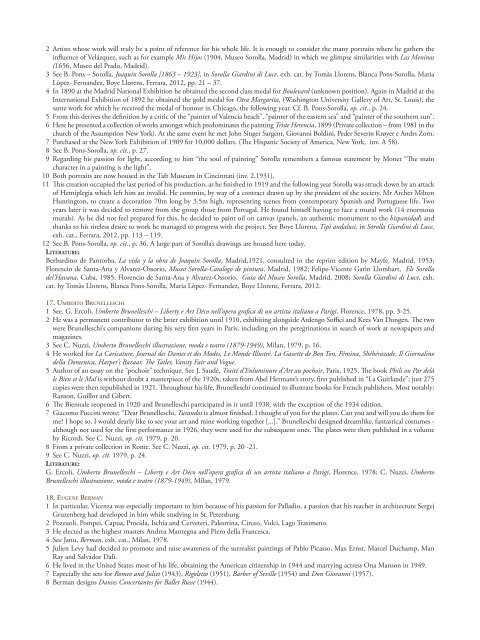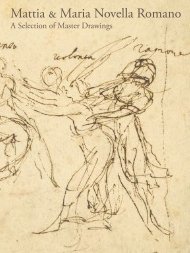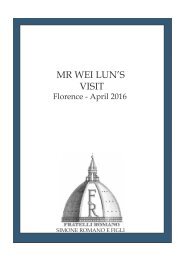A Selection of master drawings 2014
- No tags were found...
Create successful ePaper yourself
Turn your PDF publications into a flip-book with our unique Google optimized e-Paper software.
2 Artists whose work will truly be a point <strong>of</strong> reference for his whole life. It is enough to consider the many portraits where he gathers the<br />
influence <strong>of</strong> Velázquez, such as for example Mis Hijos (1904, Museo Sorolla, Madrid) in which we glimpse similarities with Las Meninas<br />
(1656, Museo del Prado, Madrid).<br />
3 See B. Pons – Sorolla, Joaquín Sorolla [1863 – 1923], in Sorolla Giardini di Luce, exh. cat. by Tomàs Llorens, Blanca Pons-Sorolla, Maria<br />
Lòpez- Fernandez, Boye Llorens, Ferrara, 2012, pp. 21 – 37.<br />
4 In 1890 at the Madrid National Exhibition he obtained the second class medal for Boulevard (unknown position). Again in Madrid at the<br />
International Exhibition <strong>of</strong> 1892 he obtained the gold medal for Otra Margarita, (Washington University Gallery <strong>of</strong> Art, St. Louis), the<br />
same work for which he received the medal <strong>of</strong> honour in Chicago, the following year. Cf. B. Pons-Sorolla, op. cit., p. 24.<br />
5 From this derives the definition by a critic <strong>of</strong> the “painter <strong>of</strong> Valencia beach”, “painter <strong>of</strong> the eastern sea” and “painter <strong>of</strong> the southern sun”.<br />
6 Here he presented a collection <strong>of</strong> works amongst which predominates the painting Triste Herencia, 1899 (Private collection – from 1981 in the<br />
church <strong>of</strong> the Assumption New York). At the same event he met John Singer Sargent, Giovanni Boldini, Peder Severin Krøyer e Andrs Zorn.<br />
7 Purchased at the New York Exhibition <strong>of</strong> 1909 for 10,000 dollars. (The Hispanic Society <strong>of</strong> America, New York, inv. A 58).<br />
8 See B. Pons-Sorolla, op. cit., p. 27.<br />
9 Regarding his passion for light, according to him “the soul <strong>of</strong> painting” Sorolla remembers a famous statement by Monet “The main<br />
10<br />
11<br />
12<br />
character in a painting is the light”.<br />
Both portraits are now housed in the Taft Museum in Cincinnati (inv. 2.1931).<br />
This creation occupied the last period <strong>of</strong> his production, as he finished in 1919 and the following year Sorolla was struck down by an attack<br />
<strong>of</strong> Hemiplegia which left him an invalid. He commits, by way <strong>of</strong> a contract drawn up by the president <strong>of</strong> the society, Mr Archer Milton<br />
Huntington, to create a decoration 70m long by 3.5m high, representing scenes from contemporary Spanish and Portuguese life. Two<br />
years later it was decided to remove from the group those from Portugal. He found himself having to face a mural work (14 enormous<br />
murals). As he did not feel prepared for this, he decided to paint oil on canvas (panels, an authentic monument to the hispanidad) and<br />
thanks to his tireless desire to work he managed to progress with the project. See Boye Llorens, Tipi andalusi, in Sorolla Giardini di Luce,<br />
exh. cat., Ferrara, 2012, pp. 113 – 119.<br />
See B. Pons-Sorolla, op. cit., p. 36. A large part <strong>of</strong> Sorolla’s <strong>drawings</strong> are housed here today.<br />
Literature:<br />
Berbardino de Pantorba, La vida y la obra de Joaquìn Sorolla, Madrid,1921, consulted in the reprint edition by Mayfe, Madrid, 1953;<br />
Florencio de Santa-Ana y Alvarez-Ossorio, Museo Sorolla-Catalogo de pintura, Madrid, 1982; Felipe-Vicente Garìn Llombart, Els Sorolla<br />
del’Havana, Cuba, 1985; Florencio de Santa-Ana y Alvarez-Ossorio, Guìa del Museo Sorolla, Madrid, 2008; Sorolla Giardini di Luce, exh.<br />
cat. by Tomàs Llorens, Blanca Pons-Sorolla, Maria Lòpez- Fernandez, Boye Llorens, Ferrara, 2012.<br />
17. Umberto Brunelleschi<br />
1 See. G. Ercoli, Umberto Brunelleschi – Liberty e Art Déco nell’opera grafica di un artista italiano a Parigi, Florence, 1978, pp. 3-25.<br />
2 He was a permanent contributor to the latter exhibition until 1910, exhibiting alongside Ardengo S<strong>of</strong>fici and Kees Van Dongen. The two<br />
were Brunelleschi’s companions during his very first years in Paris, including on the peregrinations in search <strong>of</strong> work at newspapers and<br />
magazines.<br />
3 See C. Nuzzi, Umberto Brunelleschi illustrazione, moda e teatro (1879-1949), Milan, 1979, p. 16.<br />
4 He worked for La Caricature, Journal des Dames et des Modes, Le Monde Illustré, La Gazette de Bon Ton, Fémina, Shéhérazade, Il Giornalino<br />
della Domenica, Harper’s Bazaar, The Tatler, Vanity Fair and Vogue.<br />
5 Author <strong>of</strong> an essay on the “pochoir” technique. See J. Saudé, Traité d’Enluminure d’Art au pochoir, Paris, 1925. The book Phili ou Par delà<br />
le Bien et le Mal is without doubt a <strong>master</strong>piece <strong>of</strong> the 1920s, taken from Abel Hermant’s story, first published in “La Guirlande”; just 275<br />
copies were then republished in 1921. Throughout his life, Brunelleschi continued to illustrate books for French publishers. Most notably:<br />
Ranson, Guillot and Gibert.<br />
6 The Biennale reopened in 1920 and Brunelleschi participated in it until 1938, with the exception <strong>of</strong> the 1934 edition.<br />
7 Giacomo Puccini wrote: “Dear Brunelleschi, Turandot is almost finished. I thought <strong>of</strong> you for the plates. Can you and will you do them for<br />
me? I hope so. I would dearly like to see your art and mine working together [...].” Brunelleschi designed dreamlike, fantastical costumes -<br />
although not used for the first performance in 1926, they were used for the subsequent ones. The plates were then published in a volume<br />
by Ricordi. See C. Nuzzi, op. cit. 1979, p. 20.<br />
8 From a private collection in Rome. See C. Nuzzi, op. cit. 1979, p. 20 -21.<br />
9 See C. Nuzzi, op. cit. 1979, p. 24.<br />
Literature:<br />
G. Ercoli, Umberto Brunelleschi – Liberty e Art Déco nell’opera grafica di un artista italiano a Parigi, Florence, 1978; C. Nuzzi, Umberto<br />
Brunelleschi illustrazione, moda e teatro (1879-1949), Milan, 1979.<br />
18. Eugene Berman<br />
1 In particular, Vicenza was especially important to him because <strong>of</strong> his passion for Palladio, a passion that his teacher in architecture Sergej<br />
Gruzenberg had developed in him while studying in St. Petersburg.<br />
2 Pozzuoli, Pompei, Capua, Procida, Ischia and Cerveteri, Palestrina, Circeo, Vulci, Lago Trasimeno.<br />
3 He elected as the highest <strong>master</strong>s Andrea Mantegna and Piero della Francesca.<br />
4 See Janu, Berman, exh. cat., Milan, 1978.<br />
5 Julien Levy had decided to promote and raise awareness <strong>of</strong> the surrealist paintings <strong>of</strong> Pablo Picasso, Max Ernst, Marcel Duchamp, Man<br />
Ray and Salvador Dalì.<br />
6 He lived in the United States most <strong>of</strong> his life, obtaining the American citizenship in 1944 and marrying actress Ona Manson in 1949.<br />
7 Especially the sets for Romeo and Juliet (1943), Rigoletto (1951), Barber <strong>of</strong> Seville (1954) and Don Giovanni (1957).<br />
8 Berman designs Danses Concertantes for Ballet Russe (1944).





